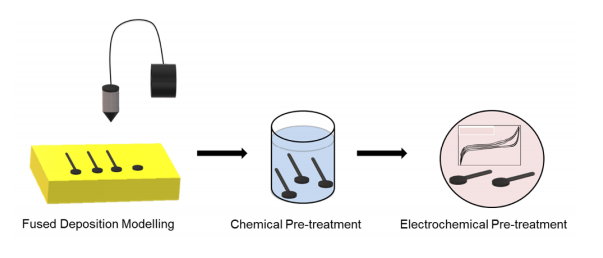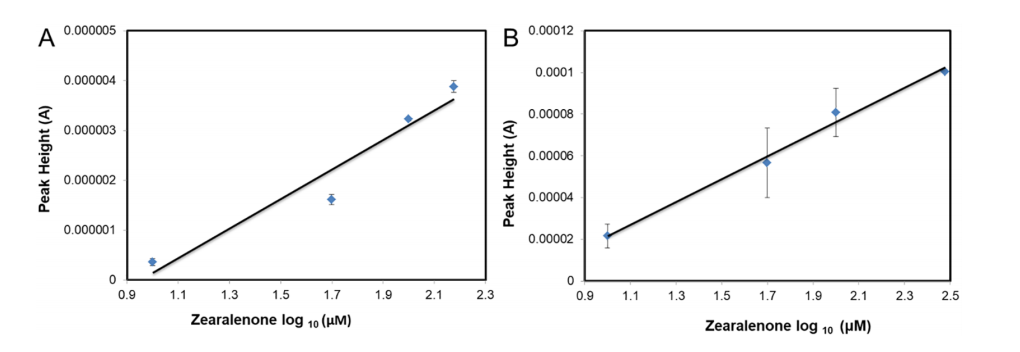International researchers have come together to explore how 3D printing can assist in food safety, detailing their findings in “3D printed electrodes for the detection of mycotoxins in food.”
While many of us may rarely worry about whether or not common food items are safe, scientists are continually working behind the scenes to improve both analysis and safety. In this study, the authors focus on better ways to detect mycotoxin zearalenone (ZEA), a contaminate of food sometimes found in cereals and other items like animal feed. Known as “poisonous secondary metabolites,” mycotoxins commonly cause growth of mold, and can be responsible for illness, the possibility of cancer, and fatalities. ZEA comes from the Fusarium fungi species and can be quite dangerous when it spreads in food storage areas.
Using an FDM 3D printer, graphene electrodes were fabricated to detect ZEA; however, pre-treatment activation was critical to ensuring performance of the electrodes. The authors used an existing method for pre-treatment, known to improve output signals substantially in detecting ZEA. The electrodes, of uniform dimensions with a length of ~4.5 cm and with a circular closed disc at one end, were designed using 3D modeling software, printed, and then soaked in N,N-dimethylformamide (DMF).

Schematic representation of the fabrication from graphene/polylactic acid filaments of 3D-printed graphene electrodes and their pre-treatment for the detection of ZEA.
“The electrochemical sensing performance of the activated 3D printed electrodes was compared with those of bare glassy carbon (GC) and edge-plane pyrolytic graphite (EPPG) electrodes, to analyze any apparent differences in current signals obtained towards the detection of ZEA,” stated the researchers. “Additionally, the voltammetric signals obtained from the GC and EPPG electrodes provide a baseline comparison with an inert electrode and a sensitive electrode surface with reactive edge plane sites, respectively.”

Cyclic voltammograms of glassy carbon (GC), edge-plane pyrolytic graphite (EPPG) and 3D-printed electrodes (the latter fabricated from graphene/polylactic acid filaments) in the detection of 100 µM ZEA (vs. Ag/AgCl). Conditions: 0.01 M phosphate buffer solution (pH 7.2) as electrolyte, scan rate 100 mV s−1.
Noting that the 3D-printed graphene electrode seemed to be less electroactive than either the GC or EPPG electrodes, the authors saw that it still detected ZEA (evidenced by the anodic peak). Taking the next step to see whether it was possible to re-use the 3D-printed electrodes, the research team experimented with different solvents, as well as skipping the washing step altogether for some of the samples. Ultimately, the electrodes not subjected to washing showed a broader anodic peak. Further study caused the team to recommend that electrodes be washed in between measurements to avoid undesirable side products.
Acetone used in washing some of the sample electrodes could have been responsible for corroding parts and prompting a reaction with the graphene layer. The possibility of a “noisy voltammetric signal” could prevent the electrodes from detecting properly:
“Hence, it might not be appropriate to wash graphene-based electrodes with harsh chemicals in order to preserve the structural integrity of the surface layer. The results obtained show that a washing step between measurements is advantageous and crucial to obtaining reproducible results. Additionally, deionised water turns out to be an ideal solvent for washing used 3D-printed activated graphene electrodes,” stated the authors.
The design could be refined further with other conductive materials, promoting increased sensitivity as well as electrochemical response. The authors recommended the possible use of transition metal dichalcogenides (TMDs) for better conductivity, and stated that additional study was needed, along with experimentation to test printed electrodes in real sample applications to find out more about interference in detection.
“This study opens the door for future improvements of 3D printed electrodes to maximize their performance through better electrode design, better choice of materials and further functionalization processes. Additionally, this proof-of-concept work opens the possibility of on-site customized fabrication of detection devices for food safety and inspection,” concluded the researchers.
While 3D printing is also associated with a variety of different types of food fabrication, many different projects have involved sensors, from monitoring diabetic health to inclusion in wearables and other materials. What do you think of this news? Let us know your thoughts; join the discussion of this and other 3D printing topics at 3DPrintBoard.com.

Calibration plots of (A) glassy carbon (GC) and (B) activated 3D-printed graphene electrodes. Conditions: 0.01 M phosphate buffer solution (pH 7.2) as
electrolyte, scan rate 100 mV s−1.
Subscribe to Our Email Newsletter
Stay up-to-date on all the latest news from the 3D printing industry and receive information and offers from third party vendors.
You May Also Like
Precision at the Microscale: UK Researchers Advance Medical Devices with BMF’s 3D Printing Tech
University of Nottingham researchers are using Boston Micro Fabrication‘s (BMF) 3D printing technology to develop medical devices that improve compatibility with human tissue. Funded by a UK grant, this project...
3D Printing Webinar and Event Roundup: April 21, 2024
It’s another busy week of webinars and events, starting with Hannover Messe in Germany and continuing with Metalcasting Congress, Chinaplas, TechBlick’s Innovation Festival, and more. Stratasys continues its advanced training...
3D Printing Webinar and Event Roundup: March 17, 2024
It’s another busy week of webinars and events, including SALMED 2024 and AM Forum in Berlin. Stratasys continues its in-person training and is offering two webinars, ASTM is holding a...
3D Printed Micro Antenna is 15% Smaller and 6X Lighter
Horizon Microtechnologies has achieved success in creating a high-frequency D-Band horn antenna through micro 3D printing. However, this achievement did not rely solely on 3D printing; it involved a combination...





























